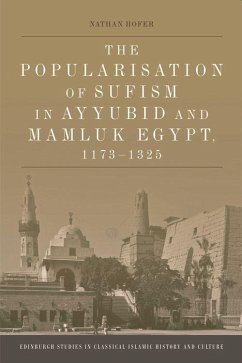'In this ground-breaking comprehensive study of Sufis in Egypt during the twelfth to fourteenth centuries, Hofer offers the first serious explanation of the popularisation of Sufism in the later middle period of Islamic history. This bold and innovative book, rich in both substance and theory, makes major advances in our understanding of medieval Sufism and deserves to be read widely by specialists and general readers alike.' Ahmet T. Karamustafa, University of Maryland A social, political and religious history of Sufism in Medieval Egypt After the fall of the Fatimid Empire in 1171 and the emergence of a new Sunni polity under the Ayyubids, Sufism came to extraordinary prominence in Egypt. The state founded and funded hospices to attract foreign Sufis and local charismatic Sufi masters appeared throughout Upper and Lower Egypt. Organised Sufi brotherhoods emerged in the urban centres of Cairo and Alexandria and even Jews took up the doctrines and practices of the Sufis. By the middle of the Mamluk period in the fourteenth century, Sufism had become massively popular. How and why did this popularisation happen? This book is the first to address the issue directly, surveying the social formation and histories of several different Sufi collectivities from the period. Nathan Hofer argues that the popularisation of Sufism during this time was the direct result of deliberate and variegated Sufi programmes of outreach, strategies of legitimation and performances of authority across Egypt. He shows that these programmes, strategies and performances are situated within the social and political contexts of the institutionalisation of Sufism, audience participation and Ayyubid and Mamluk state policies. Key Features - Offers a wide-ranging description of the variegated social landscape of Sufism in Ayyubid and early Mamluk Egypt - Presents a new theoretical model to describe the institutionalisation and popularisation of Sufism - Case studies of three different groups of Sufis in medieval Egypt track this institutionalisation and popularisation - A heuristic framework connects Sufism to larger social and political trends in medieval Egypt Nathan Hofer is Assistant Professor of Islam at the University of Missouri in Columbia. His research is broadly concerned with the social history of Sufism in the central Islamic lands, with a particular emphasis on exploring the relationship between social formation and textual production. Cover image: 'Abu el-Haggag R01' by Marc Ryckaert (MJJR) - Own work. Licensed under Creative Commons Attribution 3.0 via Wikimedia Commons Cover design: Paul Smith Design [EUP logo] www.euppublishing.com
Hinweis: Dieser Artikel kann nur an eine deutsche Lieferadresse ausgeliefert werden.
Hinweis: Dieser Artikel kann nur an eine deutsche Lieferadresse ausgeliefert werden.








